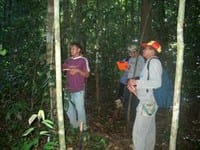



Forest Ecology and Management, 243(2-3), 187-198.
Timber logging is one of the main land uses in the Brazilian Amazon. Despite its recognized potential as a sustainable activity, logging is generally conducted in an unsustainable or predatory manner, with significant negative environmental impact. There is increasing pressure to adopt more sustainable practices and reduced-impact logging (RIL) is gaining acceptance as a more environmentally benign alternative to unplanned, conventional logging (CL). Comparisons of these two harvest systems have largely focused on differences in efficiency (financial) and immediate impacts on stand structure, residual timber stocks and the physical environment.
Growth and yield simulation models allow long-term predictions about the response of forests to disturbance from harvesting, information that is essential to determine the effects of different management systems and to establish systems for the regulation or control of timber that are compatible with sustainable forest management. We describe the calibration of a spatially explicit individual tree-based ecological model within the SYMFOR/SIMFLORA framework for forests located near Paragominas in eastern Amazonia. Data originated from an experiment comparing RIL to CL within an area of 73.5 ha monitored over a period of 10 years. We evaluated biological realism and accuracy of the model, concluding that forest dynamics are adequately represented.
This model was used to evaluate long-term effects of RIL and CL on the forest. Our results suggest that total and commercial volume recovery following RIL are faster than following CL; it takes 10 and 30–40 years to recover total and commercial volume under RIL while under CL it takes 35–40 and over 60 years, respectively. Despite benefits from RIL, as currently practiced this logging system does not result in long-term sustained timber yields, reinforcing results from previous studies indicating that RIL must be combined with appropriate systems for yield regulation.
In the absence of silvicultural treatments, the model suggests that successive RIL harvests at current intensities will produce stands dominated by pioneer species groups, with few trees belonging to the emergent species group, and an increased proportion of defective trees in commercial size classes. These changes in stand composition present challenges to the long-term financial viability of RIL as currently applied in the Amazon region.
Keywords: Forest stand dynamics; Sustainable forest management; SYMFOR; SIMFLORA; Yield regulation; Brazil; Amazon; Reduced-impact logging
O artigo está disponível para assinantes no website da revista Forest Ecology and Management ( http://www.elsevier.com/locate/foreco ).
This post was published on 6 de May de 2007
Several authors. System for Monitoring Timber Harvesting (Simex): Mapping of logging in the Brazilian Amazon…
Souza Jr, Carlos M; Marengo, José; Ferreira, Bruno; Ribeiro, Júlia; Schirmbeck, Lucimara W; Schirmbeck, Juliano;…
Several authors. System for Monitoring Timber Harvesting (Simex): Mapping logging in Amazonas State – August…
Several authors. System for Monitoring Timber Harvesting (Simex): Mapping logging in Roraima State – August…
Several authors. System for Monitoring Timber Harvesting (Simex): Mapping logging in Amapá State – August…
Several authors. System for Monitoring Timber Harvesting (Simex): Mapping logging in Pará State - August…